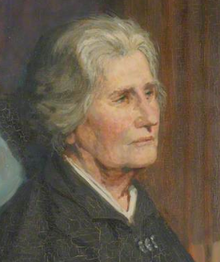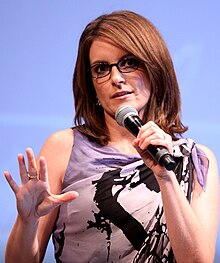Mary Paley Marshall
Mary Paley Marshall | |
|---|---|
 crop from a 1927 painting at Newnham College | |
| Born | Mary Paley 24 October 1850 Ufford, Soke of Peterborough, England |
| Died | 19 March 1944 (aged 93) |
| Nationality | British |
| Alma mater | Cambridge University |
| Occupation | Economist |
| Employer | University College, Bristol, Oxford, Marshall Library of Economics |
| Known for | One of the first women to study at the University of Cambridge |
| Spouse(s) | Alfred Marshall |
Mary Marshall (née Paley; 24 October 1850 – 19 March 1944)[1] was an economist and one of the first women to take the Tripos examination at Cambridge University in 1874, although as a woman, she was excluded from receiving a degree.[2] She was one of a group of five women who were the first to be admitted to study at Newnham College, which was the second women's college to be founded at Cambridge University.[3]
Childhood
Paley was born in the village of Ufford, near Stamford, Lincolnshire, second daughter of the Reverend Thomas Paley and his wife Judith née Wormald.[1] Her father was Rector of Ufford and a former Fellow of St John's College, Cambridge.[4] She was a great-granddaughter of the theologian and philosopher William Paley.[1]
Education
She was educated at home, excelling in languages: in 1871, after performing well in entrance exams, she earned a scholarship to become one of the first five students at the recently founded Newnham College in Cambridge.[5] She took the Moral Sciences Tripos in 1874, and was classed between a first and second-class, though as a woman she was debarred from graduation. Paley sat the exam with Amy Bulley. They were some of the first women to take tripos examinations and they sat the exams in Marion and Benjamin Hall Kennedy's drawing room. Paley described Professor Kennedy as excitable, but he would sometimes doze whilst invigilating. The only evidence she was given of her work was a confidential letter from her examiners. Women sitting the tripos examination was a milestone for Cambridge University and the importance can be gauged by the people involved. The people who delivered Paley and Bulley's papers were Alfred Marshall, Henry Sidgwick, John Venn and Sedley Taylor.[6] She was to pass with honours but this did not entitle her to an official degree. Cambridge was to resist recognising its own women graduates; a restriction that was, later, to be supported by her future husband.[7]
Life
In 1875 she was the 25 year old economics lecturer at Newnham College. Paley had established herself financially as she was the first women lecturer at Cambridge University. She was stylish and known for wearing clothes made from the fashionable prints designed by the Pre-Raphaelites.[7]
In 1876, Paley became engaged to Alfred Marshall who had been her economics tutor, and was at that time a strong supporter in higher education for women. In 1878 they moved to found the teaching of economics at University College, Bristol. Mary was one of the first women lecturers, although her salary was taken from her husband's pay as a Professor.[8] In 1883 she followed him to Oxford, before the couple returned to Cambridge in 1885 where they built and moved into Balliol Croft (renamed Marshall House in 1991) on Madingley Road. Mary lectured on economics, and she was asked to develop a book from her Cambridge lectures. Mary and Alfred wrote The Economics of Industry together, published in 1879. Alfred disliked the book, however, and it eventually went out of print, even though there was moderate demand for it. Alfred had also changed his mind about women students at Cambridge. He wrote pamphlets and letters objecting to a mixed university, and in 1897 a university law was passed preventing women from being given a Cambridge degree.
There is no record of her publicly disagreeing with her husband's support for the university's discrimination against women. She taught at Newnham and Girton until 1916 and the university did not recognise its own would-be women graduates, with a formal decree, until over 30 years after she retired.[7]
Mary was a friend of Newnham's principal Eleanor Sidgwick. In 1890 Marshall became a member of the Ladies Dining Society several of whom were associated with Newnham College. The society was started by Louise Creighton and Kathleen Lyttelton; other members of the society included Eleanor Sidgwick, the classicist Margaret Verrall, Newnham lecturers Mary Ward and Ellen Wordsworth Darwin, the mental health campaigner Ida Darwin, Baroness Eliza von Hügel, and the US socialites Caroline Jebb and Maud Darwin.[9] She had close links with women working in charity, encouraging Eglantyne Jebb (Caroline Jebb's niece by marriage) to enter this field as an assistant to her friend Florence Keynes; Eglantyne later went on to found Save the Children.[10]
그녀의 남편 알프레드는 여성들에게 쓸모가 없다고 믿으면서 점점 더 여성 교육의 대의에 훼방을 놓게 되었다.[11] 케임브리지가 여성들에게 학위를 주는 것을 고려하기 시작했을 때, 그는 친구들과 동료들의 견해에도 불구하고 이 생각에 반대하기로 결정했다. 그럼에도 불구하고 메리는 남편에게 헌신했고, 자신의 경제 저술에서 중요한 비공식 협력자였다. 알프레드의 주요 이론 작업은 경제학 원리였다. 그는 유일한 저자로 언급되지만, 메리는 그가 이 책에서 했던 것만큼 많은 일을 했을지도 모른다.[citation needed]
저명한 여성 경제학자라는 책을 쓴 제임스와 줄리안 시카렐리에 따르면, 그녀는 존 메이너드 케인즈가 쓴 전기 에세이에 이름을 올렸다. 시카렐리스는 "케인즈는 그녀를 가장 높이 평가했고 그녀를 그녀의 남편이나 그가 쓴 다른 경제학자들만큼 역사적인 경제 발전에 중요한 인물로 여겼다"[12]고 말한다.
1924년 남편이 세상을 떠난 후 메리는 케임브리지의 마셜 경제 도서관의 명예 사서관이 되었고, 그녀는 이 도서관에서 남편의 경제 관련 기사와 책을 기증했다. 그녀는 1944년 3월 19일 93세의 나이로 사망할 때까지 발리올 크로프트에서 계속 살았다.[1] 그녀의 유골은 정원에 뿌려져 있었다.[13] 그녀의 남편은 어센션 교구 묘지에 묻혔다.[14]
메리 마샬의 회고록은 사후에 What I Remember (1947년)로 출판되었다.
업적과 일
메리 마샬은 이전에 어떤 여자도 해보지 않았던 케임브리지 대학의 기말고사를 치렀다. 그녀는 비록 비공식적으로는 오랜 세월 동안 여성들이 캠브리지나 옥스포드 학위를 허락받지 못했기 때문에 명예롭게 합격했다. 1875년 메리는 뉴햄 대학에서 경제학을 가르치는 케임브리지의 첫 여성 강사가 되었고, 아마도 그녀의 학생들에게 사랑받았을 것이다.[citation needed]
그 직후인 1879년에 그녀와 알프레드는 "산업경제학"을 썼다. 이 책은 경제학과 학생들에게 인기가 있었지만 출판은 오래가지 못했다. 알프레드는 1890년에 훨씬 더 성공적인 경제 원리를 썼고, 따라서 그들의 초기 작품을 출판할 이유가 없다고 보았다. 메어리는 이것에 대한 자신의 감정을 결코 표현하지 않았고, 다시는 그녀 자신의 책을 출판하지 않았지만, 그의 글에서 알프레드를 계속 도왔다. 그러므로 메리 마샬의 경제학 연구의 실제 규모를 말하는 것은 어렵다.[citation needed]
알프레드가 죽은 후인 1924년, 그녀는 캠브리지에 마샬 경제 도서관을 세우는 것을 돕기 위해 자신의 돈을 사용했다. 그녀는 의사들이 그녀에게 멈추라고 명령할 때까지 20년 동안 그곳에서 사서로서 일했는데, 그녀는 마지못해 그렇게 했다.[15]
참조
- ^ a b c d McWilliams Tullberg, Rita (28 September 2006). "Marshall [née Paley], Mary (1850–1944), economist". Oxford Dictionary of National Biography. Oxford Dictionary of National Biography (online ed.). Oxford University Press. doi:10.1093/ref:odnb/39167. (구독 또는 영국 공공도서관 회원 필요)
- ^ "Mary Paley Marshall". www.hetwebsite.net. Retrieved 2019-03-02.
- ^ "13 women who transformed the world of economics". World Economic Forum. Retrieved 2019-03-02.
- ^ "Paley, Thomas (PLY828T)". A Cambridge Alumni Database. University of Cambridge.
- ^ Mary Paley Marshall, Newnham College, ArtUK, 2017년 2월 20일 회수된 다섯 명의 Newnham College 학생 중 한 명
- ^ Gill Sutherland (17 March 2006). Faith, Duty, and the Power of Mind: The Cloughs and Their Circle, 1820-1960. Cambridge University Press. p. 106. ISBN 978-0-521-86155-7.
- ^ a b c Kennedy Smith, Ann (20 October 2016). "Mary Paley Marshall". Sheroes of History. Retrieved 22 November 2018.
- ^ "Professor Sarah Smith with Mary Paley Marshall". January 2000.
- ^ Smith, Ann Kennedy (2018-05-09). The Ladies Dining Society. Oxford Dictionary of National Biography. Oxford University Press. doi:10.1093/odnb/9780198614128.013.109658.
- ^ Mulley, Clare (2009). The woman who saved the children : a biography of Eglantyne Jebb founder of Save the Children. Oxford: Oneworld. p. 99. ISBN 978-1-85168-657-5. OCLC 271080917.
- ^ 웨이백 머신에 2011년 11월 21일 보관된 Lucy Cavendish College의 방
- ^ "13 women who transformed the world of economics". World Economic Forum. Retrieved 2019-03-02.
- ^ "Lucy Cavendish College Site and Buildings" (PDF). Archived from the original (PDF) on 2011-09-27.
- ^ 케임브리지의 처칠 대학 가이드: 마크 골디 박사의 본문, 페이지 62, 63 (2009)
- ^ Frost, Simon (2011-11-12). "History of the Marshall Library". www.marshall.econ.cam.ac.uk. Retrieved 2021-05-03.
추가 읽기
- Cicarelli & Cicarelli (2003). Distinguished Women Economists. pp. 113–116.
- Marshall, Mary Paley (1947). What I Remember.
- Keynes, John Maynard (June–September 1944). "Mary Paley Marshall". Economic Journal. 케인즈에서 재인쇄(1972, 2010)
- Keynes, John Maynard (2010) [1972]. Essays in biography.


